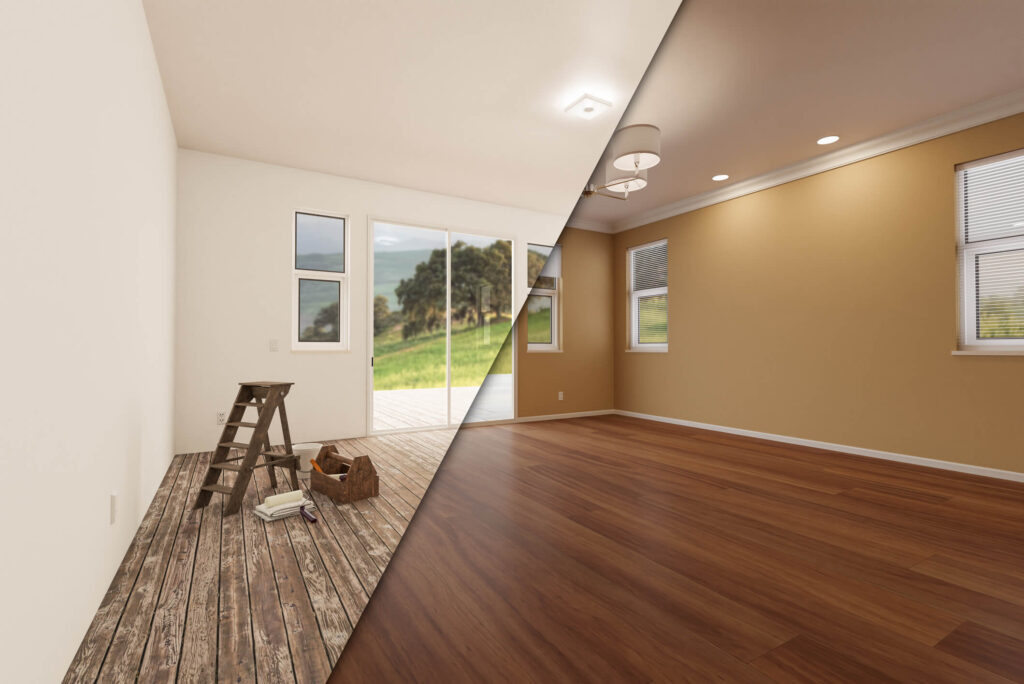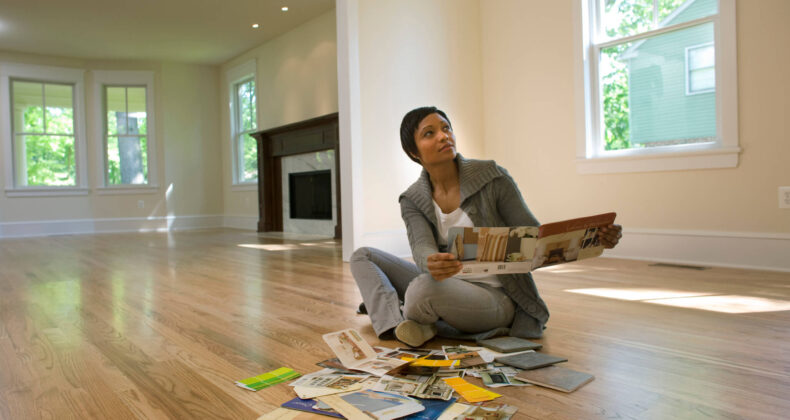The Home Upgrade Dilemma: To Build Anew or To Renovate?
Many homeowners face a dilemma when their family or housing needs and desires grow beyond the capacity or style of their current home: is it better to renovate their home and/or expand it to suit their new needs, or is it better to build a house from the ground up? This question might seem strange to those who would simply rather buy a new (but already existing) home, but that option can be prohibitively expensive in a housing market that is increasingly affected by sky-high property values and a dwindling supply of housing.
Building A New House Vs. Renovating An Existing Home
However, although the shortage of finished homes and unaffordable real estate costs may make buying a new home a non-option, building your own home or renovating a home you already own will always be options. A home renovation can increase the square footage of your house, improve and expand on your home’s functionality, increase the value and/or aesthetics and – depending on the scope of the renovation and how you go about it – be surprisingly affordable. Of course, renovation is naturally limited to some degree by the existing structure, while building a brand new home from scratch could get you the home of your dreams, and potentially even reduce some of the costs in the long term.
There is no “right” answer to this dilemma; neither renovation of your old home nor building a new home is an inherently superior option. Rather, they are two different paths to the same solution. Here are some factors to consider while making your decision.
The Price of Building A New Home
This is one of the major factors for anyone thinking about building their own home, but it should carry special importance when you are considering it in comparison to renovation. Many other factors on this list are more subjective, but the numerical price of building a new home from the ground up is a completely objective measure that you can use when weighing which option is best – and one that you can likely calculate with good accuracy long before you actually start building the new home.
“According to HomeAdvisor, the average cost to build a house in 2022 is $282,299 as of February,” writes Miranda Crace in an article posted on the Rocket Mortgage Learning Center about the cost of building personal houses. “That may sound like a lot, but it’s actually less than the median home sales price, which was $400,600 in that same month, according to the U.S Census Bureau and the U.S. Department of Housing and Urban Development’s data.”
However, just because the average cost of building a new house may be less than buying a new one, that does not necessarily mean that building a house will be cheaper than renovating. Rather, it just makes sense on an economic level; when you buy a home, you are paying for the cost of the land it is on, the cost of construction, the cost of any middlemen or real estate agents involved in organizing the sale of the home, and the profit margin of the seller. When you build your own home, you are only paying for the cost of building it and the land it is built on (in most cases – a few homeowners choose to demolish their old home and build the new home on the same plot of land, or already own land that they can build a new house on).
What Are Average Prices?
According to Home Advisor’s guide to pricing and cost-saving for building your own home, the typical residential property build project will cost somewhere in the range of $60 and $140 per square foot, if you are doing it yourself.
“Costs could run as low as $50 per square foot and as high as $200 per square foot, depending on how much labor you take on yourself, writes Ezra Laniado, Expert Contributor at HomeAdvisor, in the guide.
Here is HomeAdvisor’s prediction for total cost based on averages for the size listed:
Home Size in Square Feet = Average Cost Range to Build
- 800 Square Feet = $48,000 – $112,000
- 1,000 Square Feet = $60,000 – $140,000
- 1,500 Square Feet = $90,000 – $210,000
- 2,000 Square Feet = $120,000 – $280,000
- 2,500 Square Feet = $150,000 – $350,000
- 3,000 Square Feet = $180,000 – $420,000
- 3,500 Square Feet = $210,000 – $490,000
- 4,000 Square Feet = $240,000 – $560,000
Average costs of building a new home can be broken down into some common categories to help get a better understanding of the factors at play. These numbers are subject to a lot of fluctuation due to demand for labor, land, materials, and housing overall, but here is the general breakdown:
Buying Land And Groundwork
– Average Cost: $80,000
Before you can even begin the process of building a new home, there needs to be a place to build it. That means both buying a plot of land and making sure that it is properly cleared and prepared. That generally includes things like removing any trees, removing obstructions like boulders or smaller structures, and getting the land leveled properly.
The price tag for undeveloped land is one of the most variable of anything else in the home building process. An empty lot will cost anywhere from $3,000 to more than $75,000 depending on the size of the lot and – as you probably guessed – the “three Ls of real estate:” location, location, and location. The actual cost of land preparation is usually much less, fortunately, at around $1,500 to $3,000.
Planning, Preparation, and Permitting
– Average Cost: $7,200
After obtaining the land to build your home on, a general contractor and their subcontractors will be ready to begin preparation. Of course, they can’t just dive in – plenty of work must be done before the foundation is laid, including consulting with an architect to draw up the new home’s floor plans, any preliminary land or plan inspections necessary, and pulling all the permits required to legally build the home.
The cost varies depending on the simplicity or complexity of the project, and the corresponding inspection and permitting requirements. Permitting alone can cost more than $2,000, and along with down payments and the cost of an architect, the total will come out to around $7,000 on average.
Prepping And Building The Foundation
– Average Cost: $14,500
Once all the preparation is done, the moment you’ve been waiting for is here: time to break ground. You can enjoy the sight of a crew arriving as they begin digging out mounds of earth to make room for your new home’s foundation.
After the foundation-sized hole is ready, they will pour the specific type of concrete that fits with the type of foundation you’ve planned; this could include a slab, crawl space, basement, etc. Concrete slab foundation is the cheapest but has the obvious drawback of lacking any space beneath the first floor of your home. Since this concerns an entire story of your house (the basement) or lack thereof, it is important to consider whether a concrete slab foundation is right for you. According to Investopedia:
“Some houses don’t have a basement or crawl space under them but are simply built on a concrete slab—perhaps because the house sits on bedrock or a high water table. The concrete is poured onto the ground all at one time. Some foundations have post-tension cables or are reinforced with steel rods called rebar so that the slab can bear the weight of the house. The house is then constructed on top of this concrete foundation.”
Some advantages of concrete slab include:
- Less Time to Dry. Concrete slabs dry much faster than other options. That means less downtime and can help avoid delays. There is no need to wait the several days it takes for the concrete in a poured basement to cure and dry.
- Less Risk of Damage from Flooding or Leaking of Gasses. Radon or other gases are less likely to leak without a basement or crawlspace.
- Protection from Pests. Termites, mice and other pests are less common in homes with concrete slabs because they lack open spaces underneath the house. That means there is no space for pests to live and hide or to gain access to wooden joists and supports where they chew and make nests.
- Cost Savings. In many cases, you can shave up to $10,000 off the total house’s cost if you opt for a concrete slab. The savings are most significant when the alternative would be to carve a basement out of solid rock—a very expensive proposition.
There are disadvantages, however, including:
- Ductwork Needs Insulation. The HVAC ductwork typically runs through the ceiling of the ground floor in homes with slab foundations, requiring heavy insulation to maintain the desired temperature.
- Heating and Cooling Units Require Space. Similarly to ductwork, HVAC units such as air conditioners or furnaces may need to be installed on the ground floor, taking up room that could otherwise serve other purposes.
- Slab Cracks. Slabs have the potential to crack, which can seriously compromise the stability and structural integrity of the home. They’re also difficult and costly to repair in most cases. This can be caused by all sorts of things from tree roots and earthquakes to soil displacement or ground freeze.
Framing
– Average Cost: $35,000
Think of framing as the skeleton that supports your home. At this stage, floors must be framed and then covered with plywood or similar materials. Walls must also be framed, then raised, sheathed with plywood or alternatives like oriented strand board. Finally, trusses are placed above the wall frames to frame the roof. By and by, this process costs between $20,000 to $50,000 on average, depending on the home’s size and floor plan.
Installing External Elements
– Average Cost: $50,000
After framing, all the external elements required in the walls, roofs and the openings must be installed. First, exterior finishes like siding must be installed on the walls, then openings like windows and doors must be handled, followed by sheathing the roof (covering in shingles that are nailed on, then overlayed with roofing felt).
Installing Plumbing And Electrical
– Average Cost: $52,500
After the external elements are taken care of, it is time to install the systems that provide water, air, and electricity. HVAC and plumbing systems will be installed, and an electrician will wire the home, connecting it to the local power grid. This is a rather highly regulated step in the process with little room for cost-saving. You’ll need to use a certified electrician to make sure everything meets all current code and safety protocols.
Adding Interior Finishes
– Average Cost: $112,500
Installing interior finishes includes adding drywall, insulation, flooring, interior doors, and all the other fundamental components that will really transform the structure into a functional home. Next is the installation of cabinets and countertops, then the painting walls and installing appliances.
Often, this can become the most costly stage in the home building process but the exact price depends on your personal preference. On average, interior finishes will cost around $112,500, though they climb higher if you have expensive taste. Once this step is finished, your home’s construction will be all but complete.
Finalizing Additions
– Average Cost: $20,000
The final step includes putting in any other additions you want, like outdoor structures such as a deck or patio, a driveway, or aesthetic landscaping. The more you choose, the more it will cost. For example, adding fencing around the perimeter of your yard will run between $2,000 and $5,000, and adding a driveway costs around $6,600. All that plus inspections and final touches can total as much as 20 grand.
Is Building a New Home DIY a Good Idea?
– There is one thing that won’t cut costs – doing it yourself.
“Most people building their own house have to hire outside help for at least some of the tasks at hand,” says Laniado. “It might seem like a total DIY house build is less expensive, but the reality is that most people rely on professionals for certain building components.” Plumbing, foundation pouring, and electrical work are the most common examples. While the average DIY home build ranges from $150,000 and $500,000, many factors weigh into your total cost. Keep in mind that the costs mentioned above are just for some of the main building components.

Renovation Costs
Now that you’ve had a look at the costs of building a new home, it’s time to compare with the renovation option. As a rule of thumb, it is almost always less expensive to renovate an existing house than to buy a used home or to build a new one. Considering that materials and labor are usually the biggest factors determining the cost of renovating a home, each are typically responsible for about half of the total remodeling budget.
“Labor is usually more expensive for renovations than new home construction, where labor costs can be as low as 30% of the home,” writes Deane Biermeier and Lexie Pelchen in a Forbes article on the topic. “The most expensive room to remodel is the kitchen. Kitchen renovations include all the elements of remodeling any other space, plus plumbing, HVAC, extra electrical, cabinetry, appliances and extra planning. Bathrooms, although pricey, are in a distant second place to kitchens.”
However, you should also consider that remodeling has a substantial benefit that building a new home does not: with a good renovation, you can drastically improve the resale value of your house. Fresh renovations can make a big difference when it comes time to sell. Even remodel projects that are minimally expensive can boost home values. The best return on investment remodeling projects, according to FortuneBuilders’ Than Merrill, are:
- Minor Bathroom Remodel: Returns an average of 102%
- Landscaping: Returns an average of 100%
- Minor Kitchen Remodel: Returns an average of 98.5%
- Attic Bedroom Conversion: Returns an average of 93.5%
- Major Bathroom Remodel: Returns an average of 93.2%
- Major Kitchen Remodel: Returns an average of 91%
- Entry Door Replacement: Returns an average of 90.7%
- Deck/Patio/Porch Addition: Returns an average of 90.3%
- Basement Remodel: Returns an average of 90.1%
- Replace Windows: Returns an average of 89.6%
With the right renovations, remodeling can be a significantly better option economically, ensuring that you and your family have a secure financial future for years to come.
Other Benefits of Building a New Home
Although it is clear that renovations may be the better option in terms of pure dollar-cost, there are less tangible benefits offered by building a new home. For example, budget permitting, you’ll be able to build your new home in the perfect location. And remember, although the initial costs are almost always bigger than they are with remodeling, costs can be significantly less in a new home in the long term thanks to lower maintenance costs, energy efficiency, and avoiding future renovations. This is difficult to calculate – especially since you can’t predict the future and what renovations may or may not be necessary – but the difference might be starker if your current home is older and requires a larger maintenance budget.
Another factor is that you won’t have to live in the home during renovations. Heavy remodeling of your home can make it a headache to live in – you have to deal with construction noise, dust and debris, insulation issues, and lost access to whichever rooms are being renovated (truly a nightmare if you’re renovating the bathroom in a 1-bathroom home). This can last for weeks or even months with big projects. You can avoid all that with a new home construction; simply wait for it to be finished and move in once it’s ready.
Finally, you can add features that wouldn’t be possible with a renovation and truly build your dream home. Want a basement? It’s far cheaper to add one to a home you’re in the process of building than add one into your old home – in fact, it may be impossible if your old home rests on the wrong geology or you don’t have the immense time and money required.
Which is Better?
The fact is, there is no right answer. There is no “one size fits all” solution to housing. The best option depends on you, your family, your budget, and your needs. That being said, consider these questions before deciding:
- Is it possible to move?
- Is my family going to grow larger?
- What are the chances of moving out of town in the next 5, 10, and 20 years?
- Do I have equity in my current home to consider?
- Do I have time to wait for a new house to be built?
- What’s the state of the current real-estate market?
- What are the financing costs of either option?
- Is short-term or long-term money savings more critical to my family?
Overall, building a new home gives you the most control over the project – you can easily customize it to your precise needs and goals. However, new construction could be more expensive and take much longer than remodeling a moderately new house.
With remodeling, you are going to be somewhat bound to the existing structure, unlike the near-limitless options new construction offers. However, if you are simply trying to refresh your existing home and improve its value, renovating will likely be the more affordable and appropriate option.
At Beattie Development, we’ve operated for more than a decade and helped many clients make this decision. Contact us today – we would love to talk about your needs and wants to help you find the path that’s best for you and your family.

